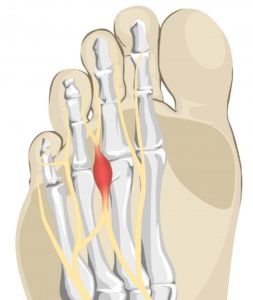
Morton’s neuroma (mortons neuroma) is a benign, sometimes painful condition that affects the ball of the foot. It’s also called an intermetatarsal neuroma because it’s located in the ball of the foot between two metatarsal bones.
A Morton’s neuroma forms when the tissue around a nerve, usually where it bifurcates (splits) leads to a toe thickens from irritation or compression. It most often occurs between the third and fourth toes.
Common symptoms

Causes
Morton’s neuroma is often caused by shoes that are too tight or that have high heels. These shoes can cause the nerves in your feet to become compressed or irritated. The irritated nerve thickens and gradually becomes more painful as a result of the pressure on it.
Another possible cause of Morton’s neuroma is a foot or gait abnormality, which can lead to instability and can also put pressure on a nerve in your foot. Many common foot deformities like flat feet, bunions and hammertoes are often present when Morten’s neuroma is diagnosed.
A neuroma may also be associated with activities such as running or any repetitive sporting activity with increased pressure in a sporting shoe. Lastly, a neuroma can occur from injury to the foot.
Conservative and home treatments
Your doctor will ask you how the pain started and physically examine your foot. They’ll put pressure on the ball of your foot and move your toes to see where you have pain. A doctor will usually be able to diagnose Morton’s neuroma just from a physical examination and by discussing your symptoms.
To rule out other possible causes of your pain, such arthritis or a stress fracture, your doctor may sometimes order imaging tests. These can include:
- X-rays to rule out arthritis or fractures
- Ultrasound images to identify abnormalities in soft tissue
- An MRI to identify soft tissue abnormalities
Injections
If your pain persists, your doctor may try injections of corticosteroids or anti-inflammatory drugs into the area of pain. A local anesthetic injection may also be used to numb the affected nerve. That may help relieve your pain temporarily.
Alcohol sclerosing injections are another remedy that may provide short-term pain relief.
Surgery
When other treatments have failed to provide relief to mortons neuroma, your doctor may suggest surgery. Surgical options may include:
- Neurectomy: where part of the nerve tissue is removed
- Cryogenic surgery: also known as cryogenic neuroablation, where nerves and the myelin sheath covering them are killed using extremely cold temperatures
- Decompression surgery: where pressure on the nerve is relieved by cutting ligaments and other structures around the nerve.
What’s the outlook FOR PATIENTS WITH MORTNS NEUROMA?
If your pain persists, your doctor may try injections of corticosteroids or anti-inflammatory drugs into the area of pain. A local anesthetic injection may also be used to numb the affected nerve. That may help relieve your pain temporarily. Alcohol sclerosing injections are another remedy that may provide short-term pain relief.
And finally surgical excision is an option, however not the primary treatment
What can you do to prevent recurrence?
One of the easiest ways to prevent recurrence of Morton’s neuroma is to wear the right kind of shoes.
- Avoid wearing tight shoes or shoes with high heels for long periods of time.
- Choose shoes that have a wide toe box with plenty of room to wiggle your toes.
- If the doctor recommends it, wear an orthotic insert to take pressure off the ball of your foot.
If you feel that this describes a foot problem you have, please contact Certified Foot & Ankle Specialists and make an appointment today to be evaluated!
